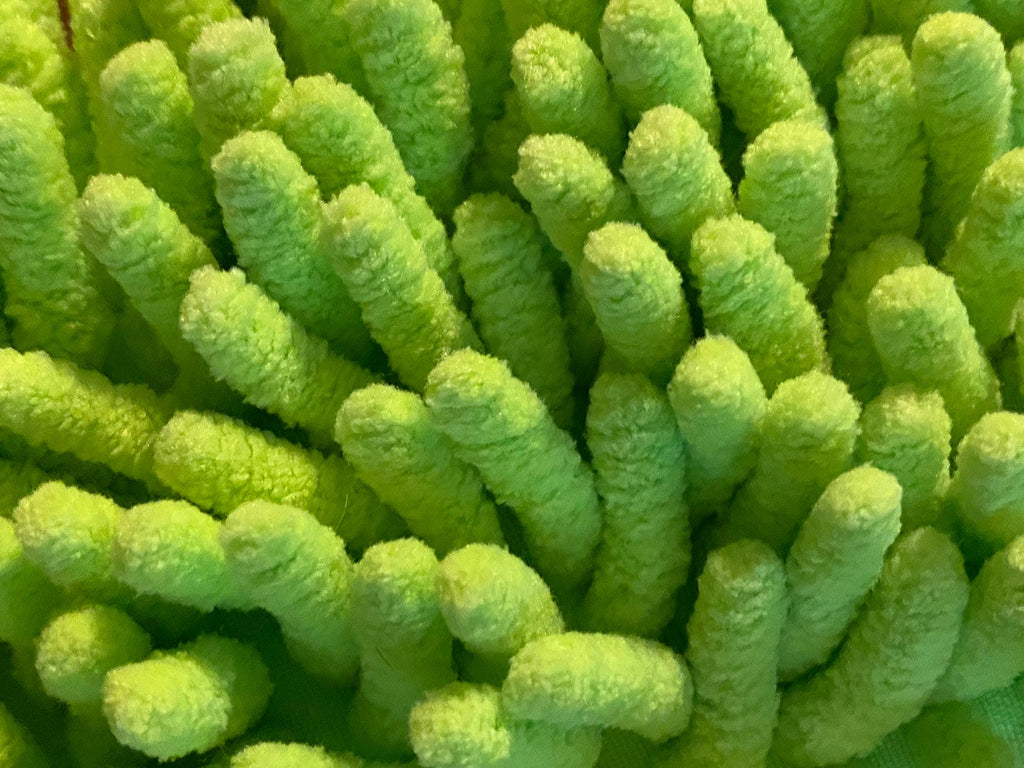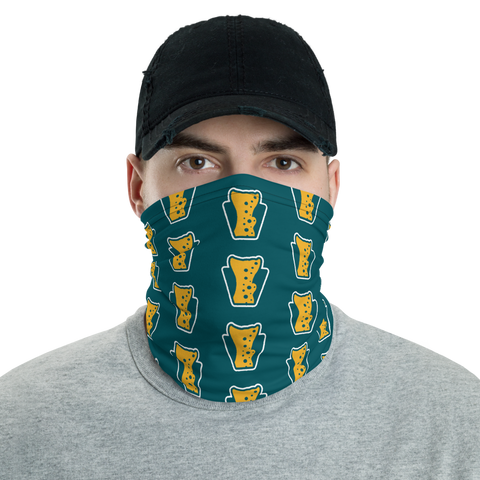
Understanding the Mop Fly
The mop fly, or as we like to simplify, "The Mop" has gained a lot of popularity and notoriety in the last few years. Famous or infamous, that opinion differs between every angler. The fact that cannot be dismissed by anyone who's ever tied one on is that mops just work. There are many theories as to why, but I don't think there is a right or wrong answer to any.
In this article, I'll lay down some storyline for my journey with the mop, and tips for fishing mops.
Part 1: "Moppin' Meloy" - A Cautionary Tale.
I'll spare some unnecessary storyline details, but I discovered mop flies in 2015-16, thanks to a teammate, Zack Smith (Thanks, Baht). My original thought was that this fly was going to single-handedly elevate my nymph game. Later I found that to be very untrue.
For a time, all I fished was a mop. Didn't matter what water type, time of year, whatever. I freakin' loved the mop.
I even got a mop tattooed on my arm. Thats dedication.

But the sad truth is, although I've won a number of sessions and a few competitions by using solely the mop, I didn't realize that the mop was my absolute crutch, and I've also noticed this theme with other anglers once they discovered the fly. If you fall into this bucket, or maybe haven't realized it yet, thats okay, there's light at the end of the tunnel.
But, after finishing very poorly in a number of competitions (and other competitors knowing me to only fish mops), where I solely used the mop, I put down the fluffy critter and reevaluated. You really don't know that your game is compromised until you have something to compare it to.
I discovered that my technique was so vastly changed from just fishing a mop that I could barely fish any other fly. I'd smack my nymphs down, drag my drifts, and use an absurd amount of slack to fish... just because I was so deep down into the worm-hole of mopping. (I did, however, discover an endless amount of ways to fish and tie mops)
The point here is that the mop can be a crutch for any angler, which pigeonholes you into a bad habit of relying on something that isn't always going to perform or ultimately form bad techniques that can hinder other facets of fly fishing. A crutch for you could be any fly really, but it shouldn't be the mop. Here's why:
The mop casts, sinks, and most importantly drifts very poorly.
It truly fishes and feels drastically different than any other fly out there. Which can be a good thing, but also a terrible thing.
Part 2: Confidence flies vs. Crutch flies.
This doesn't really have anything to do with mops, but it relates directly to my previous statement. After reading that cautionary tale, you may be asking "but what about confidence flies?" - but this has nothing to do with a confidence fly.
Confidence flies are probably the best thing you can do for yourself. Having a set of patterns that you can roll up to any stream in a certain scenario and know that you'll catch fish with. But, you don't rely on them solely to catch fish. These flies you learned to fish properly for your style of fishing which can translate to adaptation in many other scenarios. These can include many different patterns, maybe an olive mayfly style nymph pattern in the spring, a black styled pattern in the summer, eggs over the winter, something like that. Think, when you see fish rising, you probably have a dry fly pattern you have confidence in to tie on and catch that fish.
Whereas, crutch flies are flies you rely solely upon. They can dictate how you fish in every scenario. It's hard to switch back and forth and adapt when you rely on a single pattern. It may also be difficult to fish other flies with success in general, which further solidifies your crutch.
Okay, you got all that nerd stuff, let's create a seamless segue into how I fish mops situationally.

Part 3: Moppin' em up - who, what, when, where, why, and how.
Now, it may seem that my aforementioned tale means that I don't fish mops anymore, or that I may dislike or disagree with fishing them. While I may dislike that they work so well situationally, I still fish them when the time is right. And when it is right, you truly can't stop the mop.
Understanding how to fish a mop can help significantly with how poorly it drifts and sinks and increase your catch rate. For us mop veterans, we've always said "anyone can fish a mop, but knowing how to fish a mop is a blessing" - this may be true for pretty much any fly, but it is very true for the mop.
I'll cover some stuff, but taking anything here and putting into practice with your own mop groove could certainly help.
Who: You, the Mopster. The one who mops. The Trout janitor. That one was easy.
What: The Mop. My Favorite styles:
- Chartreuse (If it ain't chartreuse, it ain't no use), or Cream
- Literally any color 3.5-4mm Tungsten Slotted Bead
- #12 Trutta Goods Upside-Downie
- I don't recommend a straight shank or non-jig hook for mops
- No Dubbing. They already sink like a parachute, don't hinder it more. A naked mop is all you need.
These next ones are gonna get more detailed, buckle up.
When & Why: I normally fish a mop in the following situations:
- When trout aren't really feeding, but may feed more opportunistically. Maybe this is in the winter, or late summer. If the bite has stopped, that is a good time to switch.
- Stocked fish. Stockers love mops. Especially if there isn't much biomass or bug-life in the stocked stream.
- Large trout. Man, do big fish love mops. You may fish streamers for big fish, I'll fish a mop. I've seen big fish stick their nose out of the most unforgiving structure to munch on a mop.
- Muddy or dirty water, something bright and juicy can spark interest of a hungry trout.
- Covering water. You can cover a lot of what we call "C-water" or water that doesn't look nice, but still has fish, with a mop. More on that later.
Where: certain water types are more moppable than others. Here's what I look for:
- Deep, slow pools. Quite possibly the best mop water.
- Long flat water, any depth, aka "C-water". Basically nice looking dry-fly water.
- Any slow-current run that is pretty even. By even, I mean there's no weird currents that'll knock your mop out of its drift.
- Deep, large current seams
- Around cover or log-jams
- Undercut banks
What I rarely look for (unless its summer, or a small spring creek):
- Skinny, fast riffles
- Pocket water
- Deep, fast runs
- Something with a strong undercurrent
- Basically anything that can really hinder the drift of a mop
How: there are some specific things I do to fish mops that I've found help catch more fish and really use the mop to it's potential. The important thing to remember with mops is to let them do their thing. They're going to drift really strangely, so setting them free is the best thing to do.
The first rule of thumb I use is to never fish a tandem rig with a mop. Meaning, fishing a single mop - without another fly on the rig will greatly increase catch rate and drifts. This is because, a mop paired with any other fly will greatly hinder the drift of the other fly, and visa versa, the other fly will hinder the drift of the mop. Doing this also lets the mop drift like it should. This is an easy theory to test for yourself, but the results have been apparent for me over the years.
The next tactic I employ covers deep pools and slow runs. The secret is a little bit of slack. Contrary to most of your nymph game, don't be so tight when fishing a mop in deep water. I've found that keeping the right amount of tension to keep the fly off the bottom, but not enough to drag is key to success in deep water. This may mean that your sighter is slightly dipped, or you have a little arc in your leader. That's okay! So long as you can still feel the fish, or detect a strike, that's enough tightness. Less tension will also mean the mop will sink faster and drift more naturally.
For covering water, I use the same approach, but fish directly upstream from me. You can basically stand in the middle and fan your drifts out before moving upstream. Slacking works here, but the next tactic can work as well.
In those less-deep water where you know you'll be reaching bottom quickly, give your mop a little drag. Not like drag racing, just a little guidance. You will have to be tighter for this, so no slack if possible. This will help extend your drift, and fool some of those opportunistic feeding fish.
Last but not least, you can just dead drift them. Add a little twitching motion in there for some added movement.
To conclude, Mops are a great tool to use in moderation, when the time is right. If you feel that you rely too much on the mop (or any other fly) this may help with taking a step out of the mop-hole, which I wish I could have gotten sooner.
Thanks for reading!
Mop 'em up.
- Nick



Dmitri
Thank,s for friendly warning!, just started euro style nimphing,making my first steps and until I build a confidence box I will never use it.later maybe. Really enjoy reading your articles!
Dustin
I read fly fishing blogs like it’s my job. This is the best ever. #CantStopTheMop
Andrew Tosetti
can you us a Mop fly is ponds that are stocked with trout, and what type of retrieve would you use
Fred Vandenheuvel
Great article! Nice work Nick! I typically fish the mop on a size 12 upside downie hook and size 3.5 slotted black bead “trutta goods”with a cream body.I’ve also switched it up with a yellow, gold, and peacock dubbing. “All” have worked. Red, cream and green bodies have all been tried and all have worked in different times as well.
Bob Regish
I fish a “mop worm”. Best color is orange for me. I slit the mop in two. It comes out looking like a worm. Dead drift it on a 14 scud hook.